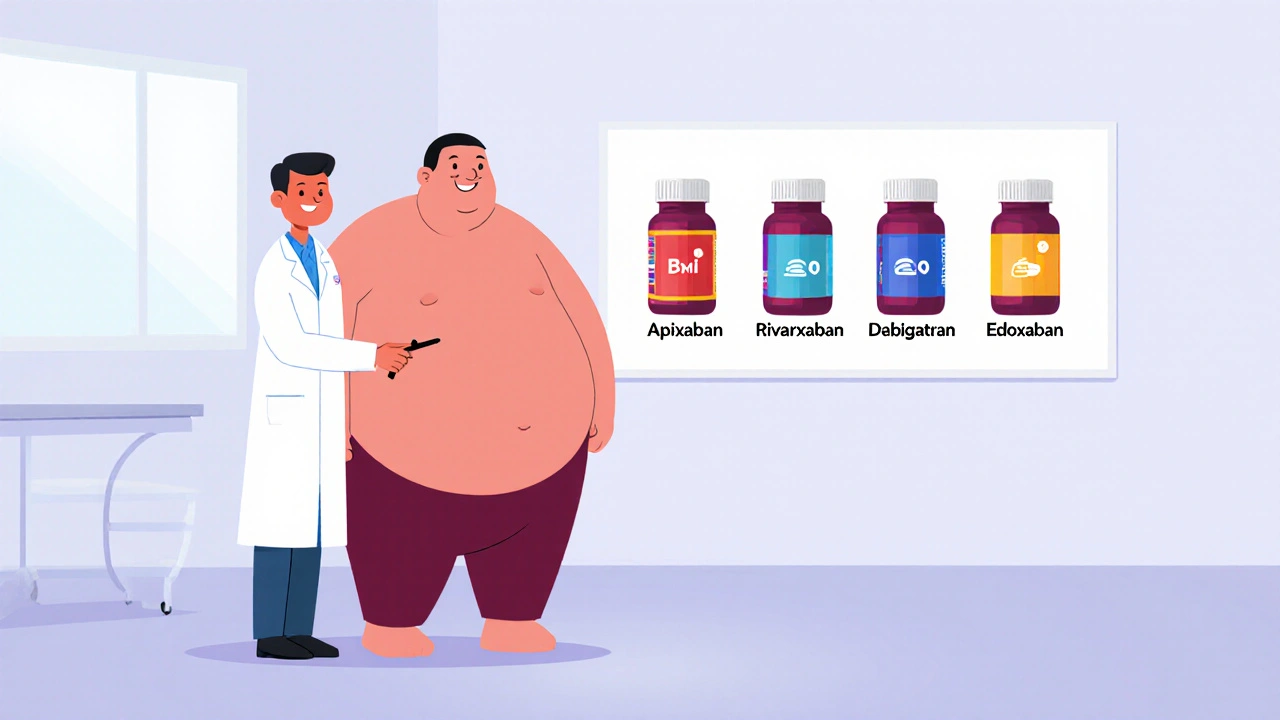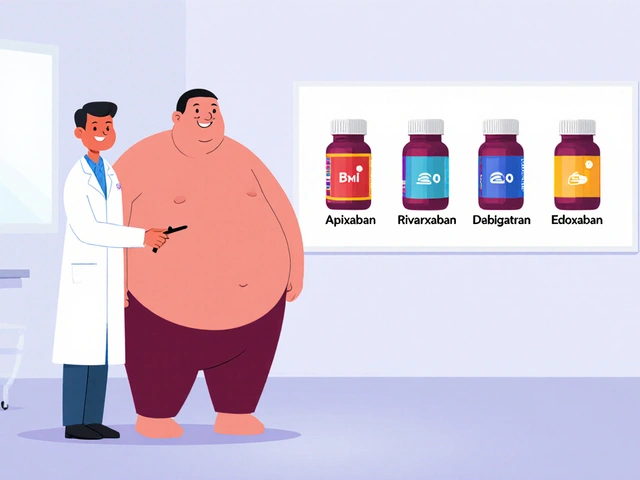DOAC Dosing Calculator for Obesity
Patient Information
When a patient carries a lot of extra weight, doctors wonder whether the usual blood‑thinner pills work the same way. The rise of direct oral anticoagulants (DOACs) has changed how we prevent clots, but the evidence in people with obesity was thin for years. This guide pulls together the latest data, guideline tweaks, and real‑world experience so you can see if standard DOAC dosing obesity is safe and effective.
What are Direct Oral Anticoagulants and why they matter
Direct oral anticoagulants (DOACs) are a class of anticoagulant medications that inhibit specific clotting factors without the need for routine blood‑test monitoring. They include apixaban, rivaroxaban, dabigatran and edoxaban, all launched between 2010 and 2015. Compared with warfarin, DOACs provide predictable pharmacokinetics, fixed dosing, and fewer food‑drug interactions, which makes them attractive for both atrial fibrillation (AF) and venous thromboembolism (VTE) treatment.
Obesity and its impact on anticoagulation
Obesity is defined as a body‑mass index (BMI) of 30 kg/m² or higher; morbid obesity is BMI ≥ 40 kg/m² or weight > 120 kg. Because obese patients were under‑represented in the original DOAC trials, clinicians questioned whether the standard doses would achieve enough drug exposure or cause excess bleeding.
Pharmacokinetic studies show only modest changes in volume of distribution and clearance for most DOACs in high‑BMI subjects. However, the clinical picture varies by drug, and the evidence base now spans over 28 studies published through mid‑2022.
Guideline snapshot - what the experts say
- 2021 International Society on Thrombosis and Haemostasis (ISTH) update recommends standard doses of apixaban and rivaroxaban for VTE treatment and AF stroke prevention regardless of BMI or weight.
- 2023 ACC/AHA/ACCP/HRS guideline gives a Class IIa recommendation favoring DOACs over warfarin in obese patients with AF.
- European Heart Rhythm Association (EHRA) 2021 Practical Guide echoes the ISTH stance for apixaban and rivaroxaban, warns caution with dabigatran, and suggests monitoring in extreme obesity (> BMI 50 kg/m²) for edoxaban.

Drug‑by‑drug look at efficacy and safety in obesity
| Drug | Standard dose for AF | Standard dose for VTE | Efficacy in obesity | Key safety signals |
|---|---|---|---|---|
| Apixaban | 5 mg BID (2.5 mg BID if ≥80 yr, ≤60 kg, Cr ≥1.5 mg/dL) | 10 mg BID × 7 days → 5 mg BID | Similar stroke/VTE rates to non‑obese; HR 0.92 (95 % CI 0.85‑0.99) in meta‑analysis. | Major bleeding comparable; no excess GI bleed. |
| Rivaroxaban | 20 mg QD (15 mg QD if CrCl 15‑50 mL/min) | 15 mg BID × 21 days → 20 mg QD | Consistent efficacy across BMI groups; HR 0.94 (95 % CI 0.86‑1.03). | Bleeding rates similar; slight increase in mild GI events. |
| Dabigatran | 150 mg BID (110 mg BID if CrCl 30‑50 mL/min) | 150 mg BID × 5‑10 days → 150 mg BID | Effective for AF, but data suggest modestly higher thrombotic events when BMI > 50 kg/m². | GI bleeding ↑ ≈ 37 % versus non‑obese; caution advised. |
| Edoxaban | 60 mg QD (30 mg QD if CrCl 15‑50 mL/min, weight ≤60 kg) | Same as AF dose after 5‑10 days of LMWH. | Trough anti‑Xa levels comparable across BMI 18.5‑>40 kg/m². | Limited data for BMI > 50 kg/m²; some reports of sub‑therapeutic levels. |
Real‑world evidence: what clinicians have observed
Large registry work gives us a clearer picture than trials alone. A 2020 JAMA‑style analysis of over 15,000 AF patients showed no meaningful difference in stroke or major bleeding when splitting the cohort at BMI 30 kg/m². The same trend held for apixaban and rivaroxaban in a 2022 Anticoagulation Forum registry of 2,147 obese patients - annual major‑bleed rates hovered around 2 % for those two drugs, while dabigatran drifted up to nearly 4 %.
Extreme obesity (BMI > 50 kg/m²) remains a gray zone. One Massachusetts General Hospital series of 347 patients reported that 18 % of those on standard‑dose edoxaban had sub‑therapeutic anti‑Xa levels, prompting some clinicians to order drug‑level testing or consider dose adjustment despite guideline cautions.
Practical dosing checklist for clinicians
- Confirm patient’s BMI or total body weight. For BMI ≥ 40 kg/m² or weight > 120 kg, standard dosing of apixaban and rivaroxaban is supported by ISTH and EHRC guidance.
- Assess renal function (CrCl) because all DOACs need dose tweaks for impaired clearance, independent of weight.
- If choosing dabigatran, discuss the ~37 % higher risk of gastrointestinal bleeding with the patient; consider gastro‑protective strategies or an alternative DOAC.
- For edoxaban in patients with BMI > 50 kg/m², consider measuring anti‑Xa activity or use the 30 mg reduced dose if drug‑level testing shows low exposure.
- Avoid empiric dose escalation. No trial data support higher than standard doses, and excess dosing raises bleeding risk without improving efficacy.
- Document shared decision‑making - note that evidence comes primarily from observational data for the highest BMI categories.
Future research directions
The ongoing DOAC‑Obesity trial (NCT04588071) aims to enroll 500 participants with BMI ≥ 40 kg/m², directly comparing standard versus weight‑adjusted dosing for apixaban and rivaroxaban. Results, expected late 2024, should settle lingering doubts about extreme obesity.
In the meantime, professional societies are calling for point‑of‑care testing that can quickly assess DOAC activity in the clinic, something that could personalize therapy for the 9 % of U.S. adults living with morbid obesity.
Bottom line for patients and prescribers
For most obese patients, especially those with BMI < 50 kg/m², the evidence backs using the same DOAC doses you’d give a non‑obese person. Apixaban and rivaroxaban lead the pack with solid safety records. Dabigatran works but carries a notable GI‑bleed signal, so weigh the pros and cons. Edoxaban appears fine for BMI up to 40 kg/m², but consider monitoring if you’re beyond that.
When in doubt, involve the patient in the decision, check renal function, and keep an eye on bleeding signs. As more data pour in, these recommendations will keep evolving, but today the standard dosing approach is both practical and evidence‑backed for the majority of obese patients.
Can I use a higher dose of apixaban if I weigh over 160 kg?
No. Current ISTH guidance states there is no evidence that doses above the standard 5 mg BID improve clot protection, and higher doses increase bleeding risk.
Is therapeutic drug monitoring needed for DOACs in obesity?
Routine monitoring isn’t required for apixaban or rivaroxaban. For edoxaban or dabigatran in extreme obesity, some clinicians order anti‑Xa or diluted thrombin time tests to confirm adequate exposure.
What about patients with BMI > 50 kg/m²?
Evidence is limited. ISTH recommends standard dosing but suggests individual assessment, possibly involving drug‑level testing or choosing a DOAC with the most reassuring safety data (usually apixaban).
Does dabigatran cause more GI bleeding in obese patients?
Yes. Meta‑analyses show a roughly 37 % increase in gastrointestinal bleeding compared with non‑obese patients, so consider gastro‑protective agents or an alternative DOAC.
Are there any DOACs that should be avoided altogether in obesity?
None are outright contraindicated, but dabigatran requires caution because of bleeding risk, and edoxaban may need monitoring in patients with BMI > 50 kg/m².








Casey Morris October 24, 2025
Having perused the recent synthesis on DOAC dosing amid obesity, one notes the ISTH endorsements-apixaban and rivaroxaban retain their standard regimens, notwithstanding the patient’s BMI; conversely, dabigatran beckons caution, given the elevated gastrointestinal hemorrhage signal; edoxaban, while generally acceptable up to a BMI of 40 kg/m², may necessitate anti‑Xa surveillance in the extreme‑obesity cohort; renal function, as ever, remains the pivotal determinant of dose adjustment, irrespective of weight; thus, the practitioner is urged to reconcile guideline pronouncements with individual pharmacokinetic nuances, ensuring that therapeutic efficacy is not compromised by presumptive dose escalation.
Teya Arisa October 26, 2025
Dear colleagues, it is heartening to see the consolidation of evidence supporting standard DOAC dosing for the majority of patients with elevated BMI. The data you presented affirm that apixaban and rivaroxaban maintain robust safety profiles, while also highlighting the need for vigilance with dabigatran and edoxaban in extreme cases. Please continue to document renal function and consider shared decision‑making with your patients. 😊
HILDA GONZALEZ SARAVIA October 27, 2025
Building upon the earlier points, the meta‑analysis you cited for apixaban indeed shows a hazard ratio of 0.92, suggesting comparable efficacy to non‑obese populations. Moreover, the real‑world registries reinforce that major bleeding rates remain around 2 % for both apixaban and rivaroxaban, which is reassuring. For clinicians grappling with BMI > 50 kg/m², a pragmatic approach could involve periodic drug‑level testing, especially when opting for edoxaban, to preempt sub‑therapeutic exposure.
Ekeh Lynda October 29, 2025
the data is clear and the guidelines are over‑stated many clinicians ignore the subtle pharmacokinetic shifts seen in extreme obesity and keep using the same doses without question the real‑world evidence shows variability in drug exposure particularly for edoxaban and dabigatran in patients with BMI over 50 the lack of rigorous prospective trials leaves a gap that should be filled before we blanketly apply standard dosing across all weight categories
Jacqueline Galvan October 30, 2025
In reviewing the comprehensive overview of direct oral anticoagulants (DOACs) within the context of obesity, several salient points emerge that deserve emphasis. First, the International Society on Thrombosis and Haemostasis (ISTH) guidance, issued in 2021, explicitly supports the use of standard dosing for apixaban and rivaroxaban irrespective of body mass index; this recommendation rests upon a substantial meta‑analysis encompassing over 28 studies, which demonstrated non‑inferior efficacy and comparable safety outcomes when contrasted with non‑obese cohorts. Second, while dabigatran’s gastrointestinal bleeding risk is amplified-approximately a 37 % increase according to pooled data-this does not preclude its utility; rather, it necessitates a judicious assessment of individual patient risk factors, including concurrent ulcer disease or the use of non‑steroidal anti‑inflammatory drugs. Third, edoxaban presents a unique scenario: its pharmacokinetic profile appears stable up to a BMI of 40 kg/m², yet beyond this threshold, isolated reports of sub‑therapeutic anti‑Xa levels have prompted recommendations for therapeutic drug monitoring or dose reduction to 30 mg daily when anti‑Xa activity is demonstrably low. Fourth, renal function remains the principal driver for dose adjustments across all DOACs, superseding concerns related to adiposity alone; clinicians should therefore prioritize accurate creatinine clearance calculations before finalizing therapy. Fifth, the burgeoning real‑world evidence, exemplified by the JAMA‑style analysis of 15,000 patients with atrial fibrillation, corroborates the absence of a statistically significant disparity in stroke incidence or major bleeding when stratified by BMI at the 30 kg/m² cutoff. Sixth, emerging data from the DOAC‑Obesity trial, anticipated to report in late 2024, will provide prospective validation of these retrospective observations and may refine dosing algorithms for the morbidly obese demographic. Seventh, practical implementation can be facilitated by a concise checklist: confirm BMI, assess renal function, discuss dabigatran‑related gastrointestinal risk, consider anti‑Xa testing for edoxaban in BMI > 50 kg/m², avoid empiric dose escalation, and meticulously document shared decision‑making. Eighth, patient education is paramount; individuals should be counseled on signs of bleeding, the importance of medication adherence, and the potential need for periodic laboratory evaluation in extreme obesity. Ninth, interdisciplinary collaboration between cardiology, hematology, and primary care can streamline the monitoring process, ensuring that high‑risk patients receive tailored therapeutic strategies. Finally, while the current evidence robustly supports standard DOAC dosing for the majority of obese patients, the field must remain vigilant, adapting practice patterns as new data emerge and as point‑of‑care testing technologies become more widely accessible.
junior garcia November 1, 2025
Great summary! Keep it simple, check the kidneys, and stick with the usual doses for most patients. 🚀
Dason Avery November 2, 2025
It’s inspiring to see how evidence evolves, reminding us that medicine is both science and art; when we align data with patient values, we truly practice healing 🌟
Kester Strahan November 4, 2025
Yo, the pharmaco‑kinetics on apix and rivar are pretty solid even in high BMI zones, but edox can be a bit sus when you go over 50, so i’d suggest a check of anti‑Xa, ya know? thx.
Doreen Collins November 5, 2025
I appreciate the balanced tone of the guide; it acknowledges both the strengths of standard dosing and the uncertainties that linger in extreme obesity. By emphasizing shared decision‑making, clinicians can empower patients while navigating the nuances of renal function and drug‑level monitoring. The checklist at the end serves as a practical tool that can be readily integrated into clinic workflows.
Amanda Vallery November 7, 2025
Thats all good but watch out for teh bleedng risks.